How Do Permeable Pavers Work? Everything You Need to Know
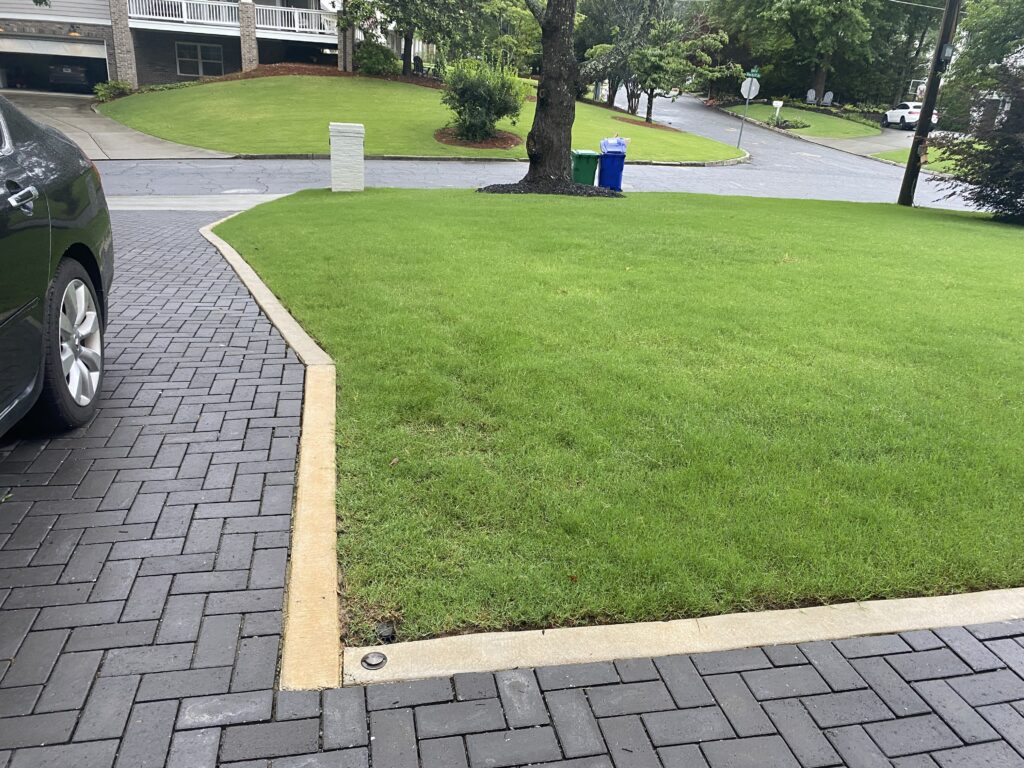
You may have heard of permeable pavers before and be wondering: how do permeable pavers work? Well, have you ever wondered what happens to the rainwater that falls on driveways, walkways, and parking lots? The answer might surprise you. Traditional impermeable surfaces can’t absorb water, leading to runoff that causes erosion, floods, and pollution. So, what’s the solution to this pressing problem? Imagine a world where stormwater isn’t a nuisance but a valuable resource. Picture a surface that not only withstands heavy loads but also manages rainwater efficiently, replenishing the earth and reducing pollution. Think about a sustainable option that enhances your property’s aesthetics while being eco-friendly. These are the promises of permeable pavers. In this article, we’ll unravel the mystery of permeable pavers and how they work. These innovative pavers are not just an alternative; they’re a revolution in construction and landscaping. We’ll dive deep into their inner workings, exploring their benefits, and understanding why they are the answer to the challenges of stormwater management. Get ready to discover how permeable pavers can transform your outdoor spaces into not only practical but environmentally responsible landscapes. Let’s embark on a journey to learn how they turn a problem into a sustainable solution. Understanding the Basics Permeable pavers, sometimes known as porous or pervious pavers, are a remarkable departure from the conventional solid surfaces most of us are accustomed to. Their unique design is a functional marvel, especially when it comes to managing rainwater. What sets them apart, however, is not the materials themselves, but the way they are assembled. In between these individual pavers, there are gaps. These gaps are not left empty but are deliberately filled with small, coarse aggregates like gravel or crushed stone. It’s these gaps and the materials within them that give permeable pavers their unique properties. Now, imagine a rainfall scenario. When raindrops fall on a typical solid surface, they collect and form puddles. This water then typically runs off, sometimes leading to issues like erosion, localized flooding, and the transportation of pollutants into water bodies. This is where the magic of permeable pavers comes into play. As rainwater hits the surface of permeable pavers, it doesn’t collect into puddles or rush off in rivulets. Instead, it infiltrates into the gaps between the pavers. These gaps act as a network of pathways for the water to move through, gradually descending into the ground below. This process remarkably mirrors nature’s way of letting rainwater seep into the earth, replenishing aquifers and nourishing plant roots. In essence, the gaps and the materials in between facilitate the controlled and managed flow of water. They turn what would be a runoff problem on solid surfaces into an eco-friendly solution. The rainwater, guided by gravity, is allowed to recharge the underground aquifers, which is vital for maintaining a sustainable water supply. But the benefits don’t stop there. Permeable pavers also incorporate a filtration system. As water infiltrates through the gaps and the aggregate materials, it undergoes a natural cleansing process. Impurities, pollutants, and debris are filtered out, ensuring that the water that eventually reaches the ground is significantly cleaner than it would be if it had simply run off a solid surface. In essence, permeable pavers are more than just construction materials; they are ingenious tools for sustainable landscaping. They offer a harmonious blend of form and function, addressing environmental concerns while enhancing the visual appeal of your outdoor spaces. So, when you consider permeable pavers, you’re not just choosing a surface; you’re choosing a water-management solution that works hand in hand with nature. It’s a transformative concept in the world of construction and landscaping. What are The Components of a Permeable Paver System? A permeable paver system is a well-structured solution that consists of several essential components working in harmony to achieve effective stormwater management. Here’s a breakdown of the key components: When all these components come together, they create a cohesive permeable paver system that not only offers aesthetic appeal but also effectively manages stormwater. The pavers themselves, supported by the base material, geotextile fabric, and subbase, work in unison to facilitate water infiltration, prevent erosion, and reduce runoff. The edge restraints maintain structural integrity, while any excess water can be managed with a drainage system. Ultimately, the native soil plays a vital role in the natural filtration and recharge of groundwater, making the entire system an eco-friendly and sustainable choice for landscaping and construction. What are the benefits of permeable pavers? Permeable pavers offer a wide range of benefits that make them an attractive choice for landscaping and construction projects. Here are some of the key advantages: How does the permeable paver reservoir work? The permeable paver reservoir is a critical component within a permeable paver system, designed to enhance the system’s efficiency in managing stormwater runoff. This reservoir plays a vital role in temporarily storing excess rainwater and allowing it to gradually infiltrate into the ground. Let’s delve into how this reservoir functions: How do Permeable Pavers Reduce Water Runoff? Stormwater runoff is a pervasive issue in urban settings. When heavy rainfall occurs, the water is often unable to permeate the surfaces it encounters. This process can lead to the erosion of the landscape, including riverbanks and streambeds. Soil erosion has far-reaching consequences, from altering the structure of water bodies to reducing the fertility of agricultural land. Furthermore, the volume and speed of stormwater runoff can overwhelm urban drainage systems. These systems are typically designed to handle a certain capacity of water flow. When they become inundated by excess runoff, it can lead to localized flooding. In urban areas, this flooding can affect streets, homes, and even businesses. It not only causes property damage but also disrupts daily life and poses safety hazards. This controlled infiltration process ensures that the water is dispersed gradually, reducing the risk of erosion. The rainwater doesn’t gain the same velocity it would on solid surfaces, meaning it’s less likely to dislodge soil and cause erosion in the landscape. Moreover,
Stamped Concrete Vs Pavers: How To Decide Between Them
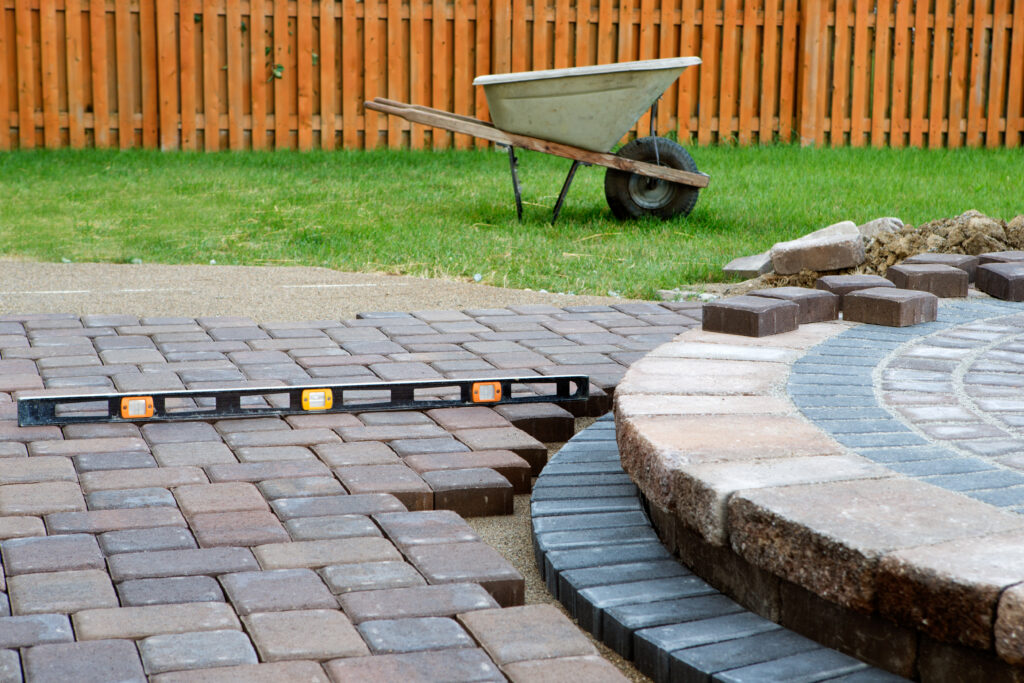
When it comes to enhancing your outdoor space, deciding to use stamped concrete vs pavers for your outdoor living space is one of the biggest decisions you’ll face. As a landscaping and hardscaping business owner, I’ve seen countless clients struggle with this very decision. They want a hardscape that not only adds beauty but also durability to their property. Stamped concrete and pavers are two of the most popular choices, each with its unique set of advantages and considerations. The question that keeps coming up is, “Which one is better for me?” In this article, I’m going to guide you through the stamped concrete vs. pavers dilemma. By the time you finish reading, you’ll have a comprehensive understanding of the benefits, drawbacks, and most importantly, which one is the right fit for your landscaping project. Get ready to pave the way for your dream outdoor space, as we explore the world of stamped concrete and pavers in depth. Let’s make an informed choice together. Aesthetic Versatility: Stamped Concrete Vs Pavers In the realm of aesthetic versatility, pavers and stamped concrete each bring their unique qualities to the table. Let’s compare these two options concerning their design flexibility and visual appeal: Aesthetic Versatility Verdict: Tie In the competition of aesthetic versatility, pavers and stamped concrete offer a close match. Pavers excel with their timeless design options and diverse color choices, allowing for intricate, customized patterns. On the other hand, stamped concrete provides a wide variety of patterns and colors, enabling you to mimic the look of various materials. The choice between these two ultimately depends on whether you prefer the classic appeal of pavers with customizability or the broader range of patterns and textures offered by stamped concrete. Both options empower you to create an outdoor space that not only meets your practical needs but is also a visually captivating masterpiece that reflects your unique style and landscape vision. Durability: Stamped Concrete Vs Pavers Durability is a critical factor when selecting materials for your outdoor space. In this comparison, pavers indeed win the durability category, but it’s important to explore the reasons behind this victory: Durability Verdict: Pavers Win In the durability category, pavers are the clear winners. Their resistance to cracking and long lifespan make them a top choice for outdoor spaces that need to withstand heavy use and harsh weather conditions. Stamped concrete, while durable in its own right, may require more maintenance and can be more prone to cracking, making it better suited for areas with lower traffic or where aesthetics are prioritized over long-term durability. When it comes to creating an enduring outdoor space, pavers take the lead. Repairability: Stamped Concrete Vs Pavers Repairability Verdict: Pavers Win Pavers clearly take the lead in terms of repairability. Their ability to replace individual units with precision and ease ensures that your outdoor space can remain in top condition without the need for extensive repairs or disruptions. In contrast, stamped concrete, while not impossible to repair, can be more challenging and may require professional expertise to achieve satisfactory results. If you prioritize an outdoor surface that can be easily and effectively repaired when needed, pavers are the superior choice. Initial Cost: Stamped Concrete Vs Pavers Initial Cost Verdict: Stamped Concrete Wins Stamped concrete wins in the category of initial cost due to its lower material costs and quicker installation. This makes it an appealing choice for those with budget constraints or those seeking a more cost-effective solution for their outdoor project. While pavers offer timeless charm and durability, they often come with a slightly higher initial investment due to the materials used and the labor-intensive installation process. If keeping your project within budget is a top priority, stamped concrete is the more economical option. Resale Value: Stamped Concrete Vs Pavers When it comes to resale value, pavers are the clear winners. We’ve discussed several factors above that give pavers a significant advantage when looking for the right paving material for an outdoor living space. This is reflected in potential buyers valuing pavers at a higher price point than stamped concrete. Resale Value Verdict: Pavers Win Pavers take the lead in terms of resale value. Their timeless appeal, durability, and the ability to create a customized and well-maintained outdoor space can significantly enhance your property’s overall value. While stamped concrete can also positively impact resale value, pavers have a reputation for offering a more substantial return on investment due to their enduring beauty and long-term durability. If you’re looking to make a wise investment in your property’s resale value and you’re deciding on Stamped Concrete Vs Pavers , pavers are the superior choice. Overall Winner: Pavers In this head-to-head comparison, pavers emerge as the clear winner, securing victories in almost all categories. Their exceptional durability, low maintenance, and unmatched design flexibility make them an excellent choice for your outdoor project. While stamped concrete has its merits, pavers offer a more enduring and versatile solution, ensuring a long-lasting and visually stunning addition to your landscape. When you choose pavers, you’re not just investing in your property; you’re investing in timeless beauty and functionality. When it comes to decididing on Stamped Concrete Vs Pavers for your outdoor project, the choice between stamped concrete and pavers hinges on several key factors. As we’ve explored in this comparison, the decision ultimately depends on your priorities, your specific needs, and the overall context of your landscape. If you prioritize a cost-effective solution with a wide range of design options and a quicker installation process, stamped concrete is the ideal choice for those who want a blend of versatility and affordability. It caters to a variety of patterns and colors, offering ample room for creative expression. However, it’s important to note that it may require more maintenance and repairs over time. On the other hand, pavers excel in terms of durability and low maintenance, making them the superior choice for those who seek a long-lasting and low-hassle outdoor surface. Their timeless appeal, ease of repair, and
5 Amazing Pet Friendly Ideas for your Outdoor Living Space

Do you have a beautiful outdoor living space but find it challenging to keep it pet-friendly? Furry companions add joy to our lives, but they can also present unique challenges when it comes to maintaining the aesthetics and functionality of your outdoor area. Torn-up flower beds, scratched furniture, and the never-ending battle against pet waste can make it seem impossible to create an outdoor haven that accommodates both your pets and your love for a well-manicured landscape. In this article, I’m going to share a collection of pet-friendly landscaping ideas that will not only help you tackle these issues but also transform your outdoor living space into a paradise where you and your four-legged friends can enjoy the great outdoors. From shade and shelter to play areas and waste management, we’ll explore solutions to create a harmonious and attractive environment for all. Let’s dive into the world of pet-friendly landscaping and make your outdoor space a haven for both you and your beloved pets. Shade and Shelter Pets, much like their human counterparts, require a comfortable and safe spot to relax in the shade, especially during scorching summer days. While we often think about our pets’ physical comfort, we sometimes overlook their need for protection from the elements. To cater to their well-being and ensure that your outdoor living space is a sanctuary for them, it’s essential to consider pet-friendly shade structures. Pergolas are an elegant and practical addition to your outdoor area. They provide shade and create a defined space for both you and your pets to unwind. Opting for a pet-friendly pergola design is not only aesthetically pleasing but also functional. You can incorporate climbing plants like jasmine or grapevines on the pergola, enhancing its visual appeal while offering natural shade. The lattice or slatted roof design allows dappled sunlight to filter through, creating a comfortable, well-ventilated space for your pets to rest. Large, sturdy umbrellas are a versatile and cost-effective way to offer shade to your pets. These can be moved around as needed, providing adaptable shelter depending on the time of day and the position of the sun. You can position them strategically in your outdoor space to create cool zones where your pets can seek relief from the sun’s heat. Look for umbrellas designed with pet safety in mind, with durable materials that can withstand your pets’ interactions. Secure Boundaries Establishing secure boundaries around your outdoor space is paramount when creating a pet-friendly environment. It’s not only about keeping your pets safe but also ensuring that unwanted guests, like critters or strays, stay out of your area. Fencing is a non-negotiable element of pet safety, but the choice of materials and design plays a critical role in achieving these goals. Why Secure Boundaries Are Crucial Choosing Pet-Friendly Fence Materials When selecting materials for your pet-friendly fence, consider the following: Pet Play Areas Designing a dedicated play area for your pets within your outdoor living space is an excellent way to ensure they get the exercise and enjoyment they need while keeping your entire yard intact and safe. Here’s an elaborate look at why and how to create such a space: The Importance of a Dedicated Play Area: Creating a Pet-Friendly Play Area: Garden Furniture with Pets in Mind Choosing outdoor furniture for your pet-friendly outdoor living space is a decision that should balance aesthetics, durability, and pet-friendliness. Your pets are part of the family, and their comfort and safety are essential considerations. Here’s an in-depth look at why selecting pet-friendly outdoor furniture matters and some excellent options: Why Pet-Friendly Outdoor Furniture Matters: Pet-Friendly Outdoor Furniture Options: Pet Waste Management Waste management holds a pivotal role in the upkeep of a clean and welcoming pet-friendly landscape. Regardless of whether you have dogs, cats, or other pets, ensuring the proper disposal of their waste is of paramount importance. An unmanaged waste situation can lead to the spread of diseases, and it hardly contributes to a hygienic outdoor environment. Aesthetically, a landscape free of waste is far more pleasing to the eye, ensuring that you can fully enjoy your outdoor space without the discomfort of unpleasant odors or the unsightly presence of waste. Establishing a regular cleaning routine is crucial, encompassing the removal of solid waste and its proper disposal. This routine aids in preventing waste buildup and maintaining a consistently clean environment. For sustainability and environmental considerations, make use of biodegradable poop bags that break down more rapidly than traditional plastic bags. When dealing with liquid waste accidents, opt for pet-friendly cleaners that provide effective cleanup without the use of harmful chemicals that could jeopardize your pets’ well-being or the environment. In more extensive outdoor spaces, composting pet waste is an eco-friendly option, provided you adhere to specific guidelines for safe and responsible composting practices. Lastly, it’s important to educate your family members and any visitors about the significance of waste management and maintain a consistent approach to this practice. Conclusion We started this journey with the challenges of balancing a beautiful outdoor living space with the needs of our pets. We’ve all been there, facing the frustration of pet-related damage and the constant battle to maintain a clean and inviting outdoor area. It’s easy to feel overwhelmed, wondering if it’s even possible to create a pet-friendly landscape without compromising on aesthetics and functionality. Your outdoor living space doesn’t have to be a battleground; it can be a paradise for your furry companions and a tranquil retreat for you. By implementing the pet-friendly landscaping ideas we’ve discussed, you can strike that perfect balance. It’s all about creating an environment that harmonizes with your pets’ natural behaviors and keeps them safe while enhancing the beauty of your outdoor space. With these ideas in mind, you’re well on your way to transforming your outdoor area into a haven where everyone can revel in the joys of nature. So, roll up your sleeves, get creative, and let your pet-friendly paradise flourish!
How to Create the Perfect Outdoor Kitchen for Your Home
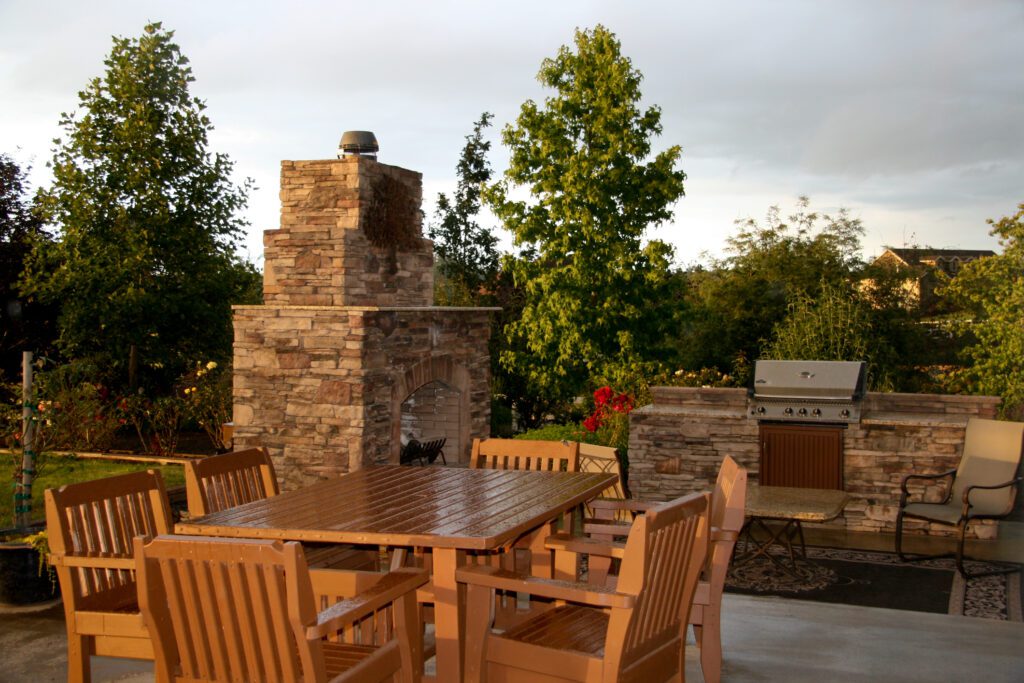
If you’re passionate about cooking and entertaining, an outdoor kitchen can be a game-changer for your home. It not only expands your living space but also allows you to savor the joys of cooking and dining al fresco. In this comprehensive guide, we’ll walk you through the steps to create the perfect outdoor kitchen that suits your style, needs, and the seasons. The allure of outdoor living has never been stronger. Whether you’re preparing a gourmet meal or simply sipping a glass of wine while the grill sizzles, the outdoor kitchen offers a unique and relaxing ambiance. There’s something magical about cooking and dining al fresco. The scent of herbs from your garden, the sound of sizzling food, and the feel of a gentle breeze all add to the experience. An outdoor kitchen not only makes meal preparation more enjoyable but also elevates the dining experience. The possibilities are as varied as your culinary imagination. Your outdoor kitchen should reflect your personality, lifestyle, and the seasonal changes that color your surroundings. We’ll help you tailor your space to ensure it’s adaptable to different times of the year. Whether you’re grilling in the warm sunshine of summer, enjoying a cozy dinner under the stars in the fall, or hosting a springtime brunch, your outdoor kitchen will be ready to accommodate your culinary desires and the evolving seasons. Plan with Purpose Planning your dream outdoor kitchen is a process that lays the foundation for an exceptional culinary and entertainment space. It all begins with meticulous planning, and this first step is vital for ensuring your outdoor kitchen aligns with your vision and practical needs. In summary, meticulous planning is the cornerstone of your dream outdoor kitchen. By defining your goals, considering additional features, addressing utilities and infrastructure, planning an efficient layout, and paying attention to aesthetics, you can create an outdoor kitchen that not only meets your culinary desires but also integrates seamlessly with your outdoor living space. So, start your planning process with precision, and you’ll be well on your way to culinary and entertainment excellence in your own backyard. Choose the Right Location Selecting the right location for your outdoor kitchen is a crucial decision that can significantly impact the functionality, convenience, and overall enjoyment of your culinary haven. When it comes to outdoor kitchen placement, several key factors come into play, each of them playing a pivotal role in determining the success of your design. Invest in Quality Appliances When it comes to designing the perfect outdoor kitchen, the selection of high-quality appliances is the heartbeat of the operation. Your outdoor kitchen’s functionality and efficiency depend on the performance and durability of the appliances you choose. While a grill is often the star of the show, there are several other essential appliances that you should consider to elevate your outdoor cooking and dining experience. High-quality appliances are the heart of your outdoor kitchen. They expand your culinary horizons, making it possible to cook a diverse array of dishes in your outdoor haven. A good grill, along with essential appliances like refrigerators, side burners, and warming drawers, ensures that your outdoor kitchen is not just a place to cook but a space to savor the joys of outdoor living. So, invest in outdoor-rated appliances that can endure the elements and elevate your outdoor kitchen to a new level of convenience and culinary creativity. Create Adequate Storage Storage is an often underestimated but incredibly crucial aspect of designing an efficient and organized outdoor kitchen. Overlooking the significance of storage can lead to clutter, disorganization, and a less enjoyable outdoor cooking and dining experience. Let’s delve into why outdoor kitchen storage is vital and how you can optimize it for your needs. Provide Adequate Counter Space Counter space is an indispensable component of your outdoor kitchen, serving as the canvas for culinary creations and the stage for presenting delightful dishes to your family and guests. Whether you’re slicing and dicing fresh ingredients, plating a beautifully crafted meal, or setting up a sumptuous buffet, having ample and well-designed counter space is crucial. Let’s explore why it’s so valuable and how to ensure it meets your culinary needs. By investing in well-designed counter space, you not only enhance the functionality of your outdoor kitchen but also create an environment that fosters culinary creativity and delightful dining experiences for your family and guests. So, ensure your outdoor kitchen is equipped with ample and well-maintained counter space to make the most of your culinary adventures. Add Shade and Lighting The incorporation of shade and proper lighting in your outdoor kitchen design is pivotal to making it a versatile and enjoyable space, regardless of the weather or time of day. Shade solutions like pergolas, umbrellas, or retractable awnings provide comfort, while well-planned lighting, including ambient, task, and accent lighting, extends the usability of your outdoor kitchen into the evening. By customizing these elements to your specific needs, you create an outdoor kitchen that is both functional and aesthetically pleasing, setting the stage for unforgettable culinary experiences and outdoor gatherings. Shade for Comfort: To maximize the usability of your outdoor kitchen, it’s essential to incorporate a source of shade. This provides relief from the sun’s intense rays during hot summer days and shelter from light rain during unpredictable weather. Shade creates a more comfortable and enjoyable environment for cooking, dining, and entertaining. Here are some options for achieving this: Proper Lighting for Versatility: Adequate lighting is equally important for your outdoor kitchen, as it allows you to extend its usability into the evening and nighttime hours. Proper lighting serves several functions: Consider Multifunctional Spaces Transforming your outdoor kitchen into a versatile entertainment space is not just about cooking delicious meals but also about creating a welcoming and multifunctional area where you can relax, dine, and socialize. By thoughtfully designing your outdoor kitchen to encompass various zones, you can make the most of your outdoor living space and enhance its utility and charm. An outdoor kitchen is not
Fall Features For Your Backyard: The Best of the Best
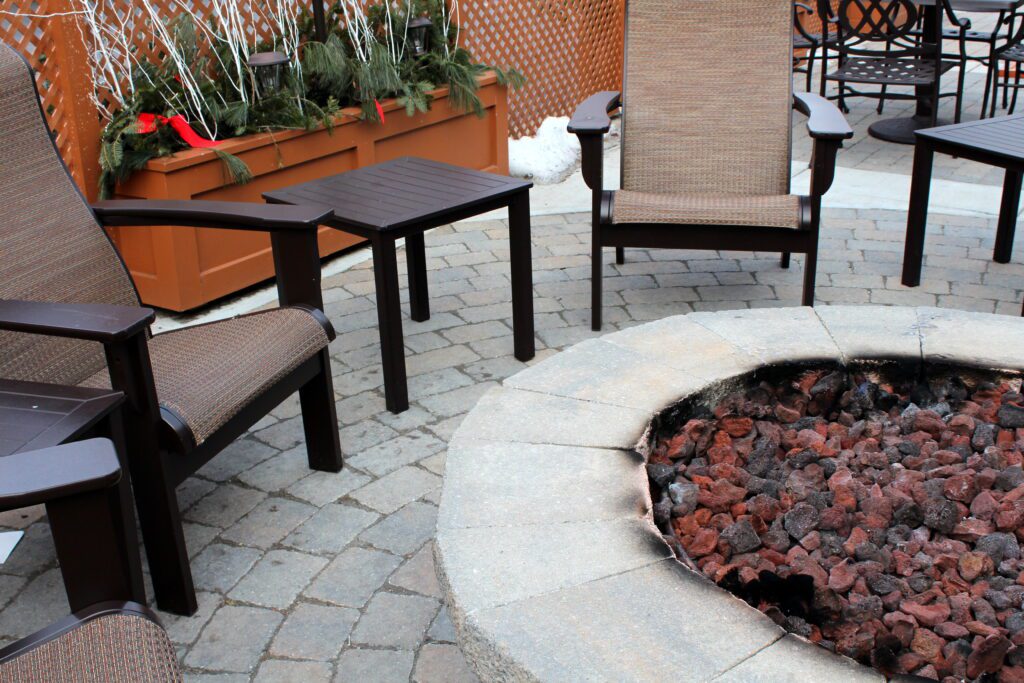
As the leaves change and the weather turns cooler, the fall season provides a wonderful opportunity to enhance your backyard. By adding fall features that not only beautify the space but also transform it into a warm and inviting retreat, you’ll create a haven for you, your family, and friends to enjoy. In this article, I’ll delve into various exciting features that you can consider incorporating into your backyard during the autumn months. Fall Fire Features For Family Fun When the crisp autumn air sets in and the leaves begin to change, there’s something undeniably enchanting about a fire pit or outdoor fireplace. These features not only serve as functional sources of warmth but also as focal points that enhance the overall ambiance of your outdoor space. Incorporating a fire pit or outdoor fireplace into your backyard during the fall season not only elevates the aesthetics but also provides a gathering point that promotes warmth, connection, and unforgettable moments. It’s a multi-functional addition that caters to your physical and emotional well-being, turning your backyard into a year-round haven. So, whether you’re craving the warmth of the fire, the taste of roasted marshmallows, or simply the company of loved ones, this feature has it all covered. Pergola or Gazebo Adding a pergola or gazebo to your backyard is a dual-purpose investment that seamlessly blends form and function. It’s not just about shade; it’s about elevating the aesthetics of your outdoor space. So, if you’re looking to elevate your outdoor living experience, consider adding a pergola or gazebo to your backyard this fall, and watch it transform into a haven of comfort and elegance. Holiday Cooking With Your Outdoor Kitchen Fall is a season that beckons us to enjoy the outdoors without the oppressive summer heat. Creating an outdoor kitchen during this time can be a game-changer, allowing you to indulge in culinary delights in a comfortable and pleasant setting. An outdoor kitchen equipped with a grill, countertops, and storage can indeed transform your backyard into a culinary paradise during the fall season. It’s a space where you can escape the heat, cook delicious meals, entertain friends and family, and create lasting memories. So, if you’re a culinary enthusiast and a lover of outdoor living, consider the advantages of this addition and get ready to savor the flavors of fall in your very own outdoor haven. Lighting for Your Fall Outdoor Living Space As the days grow shorter in the fall, outdoor lighting becomes crucial for safety and creating a captivating ambiance. By combining landscape lighting, string lights, pathway lights, and the allure of firelight, you can transform your backyard into a warm and inviting haven. So, illuminate your outdoor space strategically, and enjoy the enchantment of your well-lit backyard during the fall evenings. Outdoor Seating and Furniture Comfortable outdoor furniture is an essential component of your fall backyard experience. It provides a cozy space for relaxation, entertainment, and appreciation of the season’s beauty. By investing in durable, weather-resistant pieces, you can ensure that your outdoor furniture remains in excellent condition and continues to enhance your outdoor haven for years to come. Fall is a time of year when spending quality time in your backyard becomes a cherished ritual. Comfortable outdoor furniture plays a vital role in enhancing this experience, providing a space where you can relax, entertain, and appreciate the beauty of the season. Kids’ Play Area By creating a dedicated play area with kid-friendly features, you not only provide a space for your children to play and explore but also enhance family bonding and outdoor enjoyment during the fall season. It’s a space where imaginations run wild, laughter fills the air, and precious memories are created. Consider integrating a play area into your backyard and watch your entire family revel in the beauty of autumn while having fun and staying active together. Conclusion As you begin to incorporate these delightful features into your backyard this fall, you’re embarking on a journey of transformation. Your outdoor space, once a mere backdrop, is about to become a cherished haven for you, your family, and all your guests. The allure of fall’s vibrant colors and crisp air will be amplified by these additions, creating an atmosphere of relaxation and togetherness that everyone will love. However, it’s essential to remember that the process of enhancing your backyard demands careful planning and budgeting. Each feature you choose, whether it’s a fire pit, pergola, outdoor kitchen, or any other element, comes with its own set of considerations. By planning meticulously, you can ensure that the final result aligns with your vision and suits your needs. Moreover, for those seeking professional guidance and expertise, don’t hesitate to consult with a landscaping or construction expert. Their insights and experience can be invaluable in making the best choices and optimizing the layout and design of your backyard. Whether it’s choosing the right materials, ensuring structural integrity, or navigating local regulations, professionals can provide the guidance needed to bring your vision to life. In conclusion, as you embark on this journey to enhance your outdoor space this fall, remember that the beauty of autumn is best enjoyed in a backyard that has been thoughtfully curated to create a welcoming retreat. With the right features, a solid plan, and, if necessary, professional guidance, your enhanced outdoor space will be a source of joy and relaxation for you and your loved ones. So, go ahead and savor the splendor of fall in your newly transformed haven, and make the most of the season in your own piece of outdoor paradise.
How to Cut Pavers: The 3 Best Methods
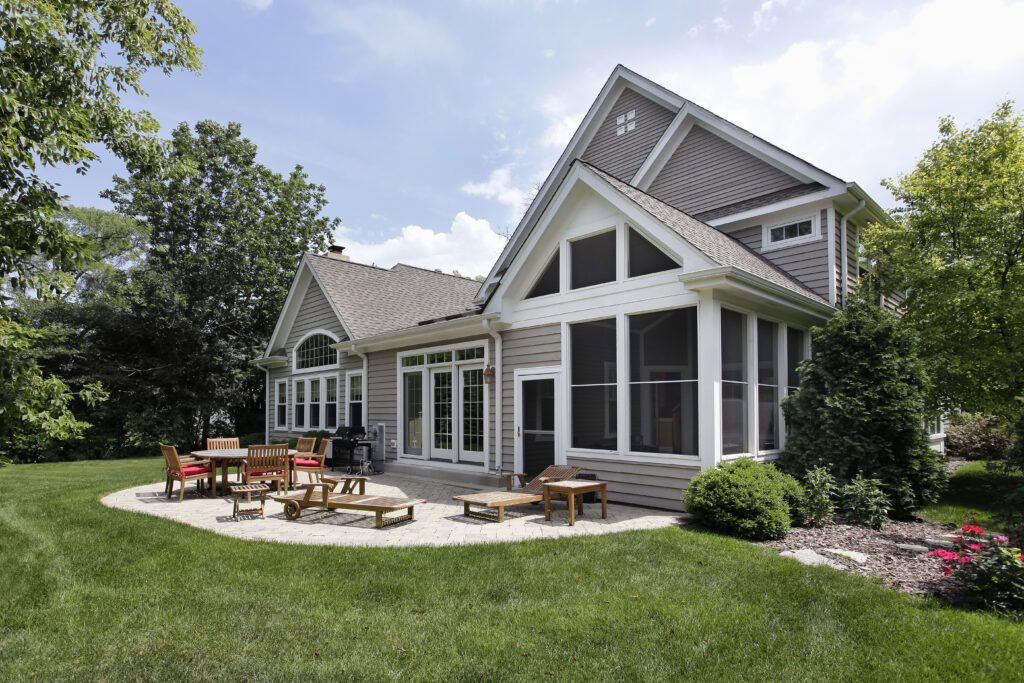
Cutting pavers is a skill that can transform your landscaping or construction project from ordinary to extraordinary. Whether you’re creating a stunning patio, a winding pathway, or constructing intricate designs, knowing how to cut pavers is essential for achieving the perfect fit and finish. But, it’s not just about grabbing a saw and slicing away. Precision, safety, and the right tools are key. In this comprehensive guide, we’ll walk you through the art and science of cutting pavers, sharing techniques, tips, and insights to help you master this essential skill. Whether you’re a seasoned DIY enthusiast or a professional contractor, you’ll find valuable information here to elevate your paver projects to a whole new level. Why Do You Need To Cut Pavers? Cutting pavers is a necessary skill because it allows you to customize the layout of your project to fit your design vision and space requirements precisely. While pavers come in standard shapes and sizes, landscapes and construction projects often demand unique configurations due to factors like curves, corners, or obstructions. Cutting pavers enables you to: Essential Tools and Safety Precautions to Cut Pavers When it comes to cutting pavers, having the right tools and prioritizing safety are paramount. Here’s a list of necessary tools and safety gear, along with some tips on maintaining a well-ventilated workspace: Tools to Cut Pavers: Safety Measures: By ensuring you have the right tools and following these safety measures, you can effectively and safely cut pavers for your landscaping or construction project, all while minimizing health risks and hazards. Choosing the Right Method to Cut Pavers Cutting pavers is a common task in landscaping and construction, and various methods can be employed to achieve precise cuts. Here, we’ll discuss three primary methods for cutting pavers – using a wet saw, a chisel and hammer, and a guillotine-style splitter – along with their pros and cons to help you choose the most suitable method for your project. Wet Saw: Pros: Cons: Chisel and Hammer: Pros: Cons: Guillotine-Style Splitter: Pros of : Cons: Selecting the Most Suitable Method: Ultimately, the choice of cutting method depends on the specific requirements of your project, your budget, and your comfort level with the chosen tool. It’s essential to prioritize safety and precision while considering these factors. Cut Pavers with a Wet Saw Using a wet saw is an efficient method for cutting pavers. Here’s a step-by-step guide on how to use a wet saw for cutting pavers: Step 1: Set Up the Wet Saw: Step 2: Adjust the Saw: Step 3: Mark the Paver: Step 4: Position the Paver: Step 5: Start the Wet Saw: Step 6: Make the Cut: Step 7: Finish the Cut: Step 8: Test Your Cut: Step 9: Repeat as Necessary: Using a wet saw can provide clean and precise cuts on pavers, making it a popular choice for various projects. Remember to prioritize safety, maintain your equipment, and practice patience to achieve the best results. Cut Pavers with Hand Tools Using a chisel and hammer for smaller cuts or a guillotine-style splitter for more substantial cuts are alternative methods for cutting pavers. Here’s a guide to each technique: Chisel and Hammer Method (Smaller Cuts) This method is suitable for making smaller, controlled cuts on pavers. Steps: Guillotine-Style Splitter (Larger Cuts) This method is ideal for larger cuts, such as when you need to split a paver in half. Steps: Tips for Clean Hand-Cuts: Both of these methods are suitable for specific cutting needs, but they may not provide the precision and uniformity that a wet saw can offer for more complex projects. Conclusion Cutting pavers may seem like a daunting task, but armed with the right knowledge and tools, it becomes an achievable skill. The key to success lies in choosing the appropriate cutting method, prioritizing safety, and carefully planning your cuts. Remember to measure accurately, mark your pavers clearly, and apply even pressure during the cutting process. Safety should always be paramount, so don’t forget your protective gear, maintain a clean workspace, and follow manufacturer guidelines for tool operation. Common problems like chipping and cracking can be mitigated with a little know-how. Practicing on spare pavers will boost your confidence and skill level. Additionally, if dust is a concern, opt for a wet saw or work in a well-ventilated area. Efficiency also plays a role, so plan your cuts to minimize waste and save time. With these tips in mind, you’re well-prepared to tackle your paver cutting projects with confidence. Whether you’re enhancing your patio, walkway, or driveway, the precision you achieve will bring your landscaping and construction projects to life. We invite you to share your experiences, questions, or additional tips. Your engagement is valuable, and we’re here to support your paver cutting endeavors.
How Much Slope Should A Paver Patio Have? Everything You Wanted To Know
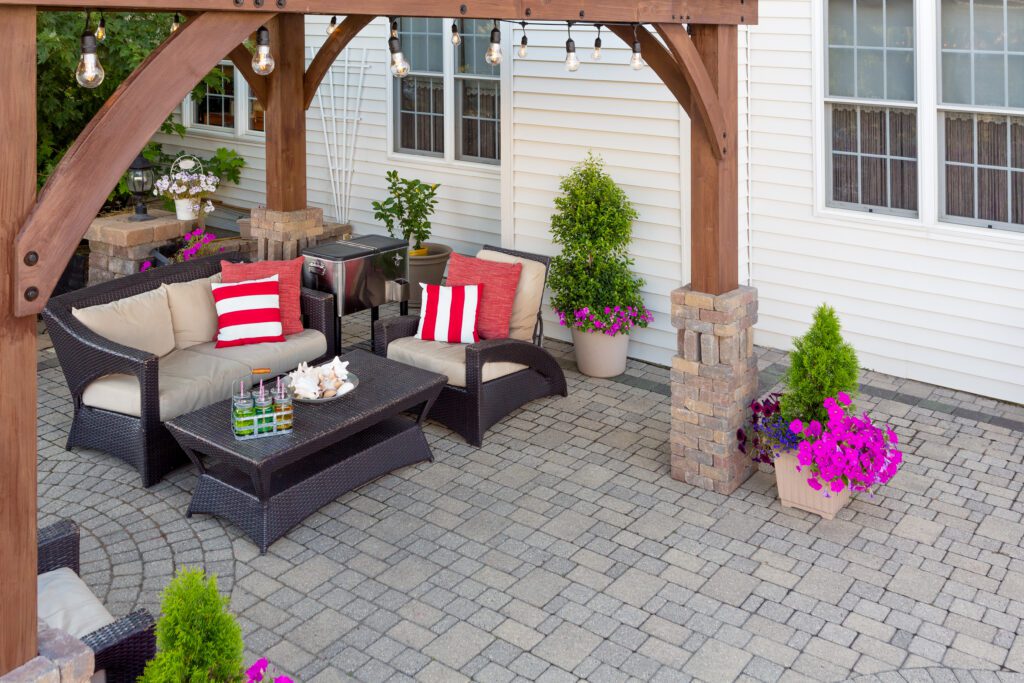
When it comes to creating a paver patio, one of the fundamental considerations is getting the slope just right. The slope of your patio plays a pivotal role in its functionality and durability. Too much slope can make it uncomfortable to walk on, while too little slope can lead to drainage problems and puddles. So, how much slope should a paver patio have? In this article, we’ll delve into this crucial question, exploring the ideal slope measurements and the reasons behind them. Whether you’re planning to embark on a DIY patio project or working with professionals, understanding the importance of slope will ensure that your patio not only looks great but also performs flawlessly. How Much Slope Should a Paver Patio Have? A slope of 1/4 inch per foot away from the house is a commonly recommended guideline for paver patios. A slope of 1/4 inch per foot may appear subtle to the naked eye, but it provides enough gradient to guide water flow in the right direction. Maintaining a level surface for your patio is essential for comfort and usability. A perfectly flat patio might look appealing, but it can create issues with water drainage, as we discussed earlier. On the other hand, a steeper slope can make walking uncomfortable and pose challenges when arranging furniture. The 1/4 inch per foot slope strikes a balance, ensuring that your patio remains comfortable for everyday use. What Happens If a Patio Is Perfectly Level? While a level patio may seem visually appealing and symmetrical, it can inadvertently create water-related challenges. Without a slight slope for proper drainage, water has no clear path to follow when rain or runoff occurs. Here’s what can happen: How to Fix a Patio with an Improper Slope? Addressing an improper slope on your paver patio is essential to prevent water-related issues. The approach you choose to rectify an improper slope on your paver patio depends on the severity of the issue and your specific preferences. Whether you choose to disassemble and re-lay the pavers or opt for a drainage solution like a catch basin or channel drain, professional guidance can be invaluable. Professionals have the knowledge and experience to ensure that the corrected slope effectively manages water runoff, protecting your patio and home from potential water-related problems. What Factors Should Be Considered When Choosing the Slope Direction for a Patio? When determining the slope direction for your patio, several key factors should be taken into account to ensure effective water management and overall functionality: The slope direction for your patio should be a carefully considered aspect of your landscape design. It should align with the natural flow of water, avoid potential issues near your home’s foundation, and seamlessly integrate into your outdoor layout. Striking a balance between effective drainage and usability is key to creating a functional and aesthetically pleasing patio. How Can I Check If My Paver Patio Has the Correct Slope? Ensuring that your paver patio has the correct slope is essential for effective water drainage and preventing issues like puddling or water damage. Here’s a step-by-step guide on how to check if your paver patio has the correct slope: By following these steps and measuring the gap between the straightedge and your pavers, you can confidently determine whether your paver patio has the correct slope for efficient water runoff away from your house. If adjustments are needed, addressing them promptly will help prevent potential water-related issues in the future. Are There Any Special Considerations for Sloped Patios in Hilly Areas? Sloped patios in hilly areas present unique challenges and opportunities for homeowners looking to create functional and aesthetically pleasing outdoor spaces. Here are some special considerations for sloped patios in hilly areas: In summary, sloped patios in hilly areas require thoughtful planning, taking into account the natural topography, drainage needs, and safety considerations. While they present challenges, they also offer the opportunity to create unique and stunning outdoor spaces that make the most of the landscape’s character. Consulting with professionals with experience in hilly terrain is often the best approach to ensure a successful and beautiful sloped patio. Conclusion In conclusion, understanding and implementing the correct slope for your paver patio is crucial for its functionality, longevity, and aesthetics. Whether you’re working with a flat surface or dealing with a sloped terrain, ensuring proper drainage away from your home is essential to prevent water-related issues and structural damage. The ideal slope of approximately 1/4 inch per foot away from the house strikes the right balance between effective drainage and a level surface suitable for various activities. However, it’s equally vital to consider the unique characteristics of your landscape, such as hilly terrain, natural drainage patterns, and the need for retaining walls or grading adjustments. If you find that your patio lacks the correct slope, there are solutions available, including reinstallation or the addition of drainage systems. In hilly areas, working with the natural contours and consulting with professionals can help you create a patio that not only serves its practical purpose but also complements the beauty of your outdoor space. Ultimately, a well-planned and properly sloped paver patio enhances your home’s value, provides a comfortable and safe outdoor area, and allows you to enjoy the beauty of your surroundings. So, whether you’re designing a patio for relaxation, entertaining, or simply enjoying the outdoors, remember that getting the slope right is a fundamental step toward a successful and enjoyable outdoor living space.
How Do I Know if I Need a Retaining Wall? 6 Signs To Look For
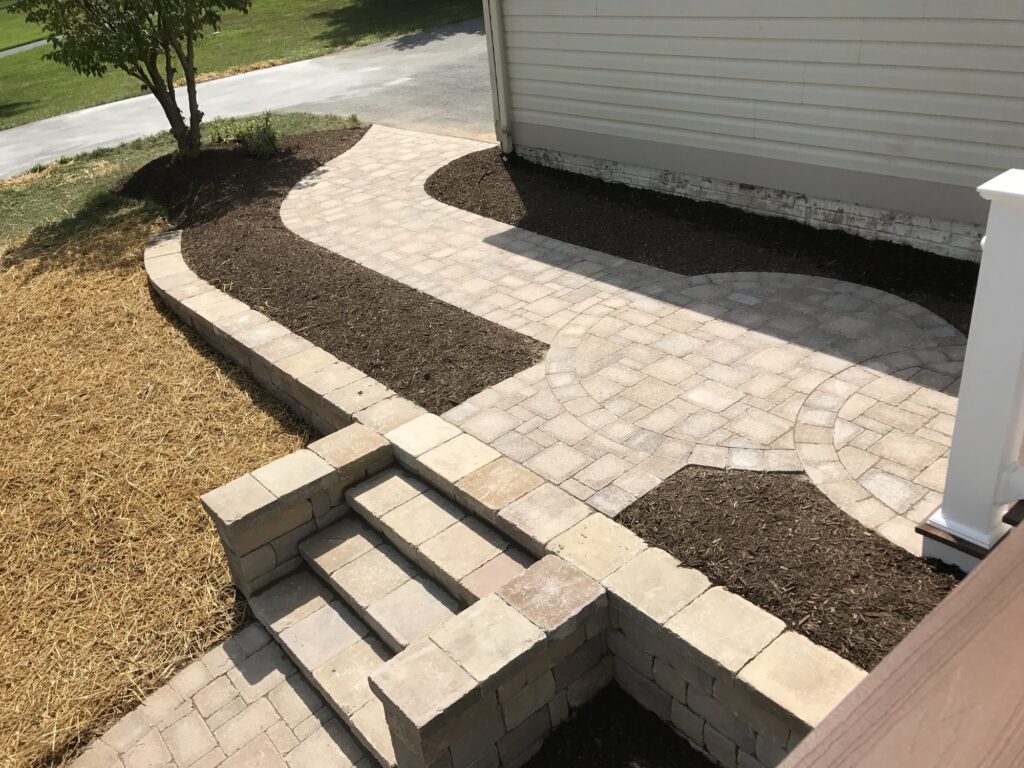
Your property, with its unique topography and landscaping challenges, might just be the perfect candidate for a retaining wall. These architectural marvels don’t just add visual appeal to your landscape; they also serve crucial functional purposes. So, how do you determine if you need a retaining wall on your property? Let’s delve into the signs, situations, and considerations that can guide this decision. You Have Uneven Terrain and Sloping Land Uneven terrain can present both visual and practical challenges for property owners. If your land boasts significant slopes, hills, or varying elevations, the introduction of retaining walls can be a transformative solution. Beyond aesthetics, these walls play a pivotal role in leveling and stabilizing the ground, effectively addressing issues like soil erosion and creating functional, usable spaces on sloping land. Uneven terrain can result in awkward, unusable spaces and may compromise the overall visual appeal of your property. Retaining walls come to the rescue by providing a means to level the ground. They create flat surfaces that are not only aesthetically pleasing but also functional, enabling the creation of gardens, patios, or seating areas that were once impractical due to the slope. You Have Erosion Issues Nature’s forces, especially heavy rains, can sometimes turn into silent menaces, causing gradual but significant damage to your property. If you’ve noticed soil erosion, with rainwater washing away valuable topsoil and creating uneven surfaces, you could use a retaining wall. Soil erosion, often a stealthy process, can manifest in various ways. After heavy rains, you might observe gullies forming on your property, the topsoil being carried away, or even uneven surfaces developing. These are all telltale signs of soil erosion, a process that can rob your land of its fertile soil and gradually alter its topography. Retaining walls emerge as the guardians of your property when faced with soil erosion. They serve a dual purpose in combating this menace: Topsoil is the lifeblood of your landscape, rich in nutrients and essential for healthy plant growth. Soil erosion can strip away this valuable resource, leaving behind less fertile soil that hampers plant growth. Retaining walls ensure that your topsoil remains in place, preserving its quality and sustaining the vitality of your plants. Your Property Has Elevation Changes A dynamic and visually engaging landscape often benefits from changes in elevation. These elevation changes can bring character, functionality, and a sense of flow to your outdoor space. This is where the versatile beauty of retaining walls comes into play. They are not just functional structures; they are design elements that can transform your landscape by creating distinctive levels and providing essential support for raised patios and seating areas. Elevation changes are the contours and shapes that can turn a flat canvas into a masterpiece. Retaining walls are your tools for creating these changes: Beyond their aesthetic role, retaining walls provide critical support for raised patios and seating areas: You Have Excess Water Accumulating Water, while essential for life, can sometimes pose a threat to your property, especially when it accumulates in excess. Whether it’s from natural springs, heavy rainfall, or poor drainage, water buildup can be a concern, potentially leading to damage to your property’s foundations. This is where the formidable presence of retaining walls comes into play, diverting excess water away from vulnerable areas and effectively managing moisture to safeguard your property. Water accumulation can manifest in various ways on your property. It might result from the natural flow of groundwater, heavy downpours, or inadequate drainage systems. Regardless of the source, excessive water buildup can lead to several issues: Retaining walls stand as formidable allies in managing excess water. Here’s how they effectively combat water buildup: You Need Support for Structures Retaining walls are often essential for supporting structures like homes, garages, or driveways on sloped terrain. They provide the necessary stability to ensure the safety and longevity of these structures. When your property is perched on sloped terrain, the safety and longevity of your structures, such as homes, garages, or driveways, can become a significant concern. Retaining walls play a pivotal role in providing the essential stability required to ensure the safety and durability of these vital elements of your property. Your Property Could Use Some Visual Enhancement Beyond their indispensable functional benefits, they possess the remarkable ability to elevate the aesthetics of your landscape. These versatile structures come in a wide array of materials and styles, granting you the creative freedom to select a design that harmonizes seamlessly with the overall look and feel of your outdoor space. Imagine your property as a blank canvas, waiting to be transformed into a work of art. Retaining walls are your brushes, and the choice of material and style is your palette. Here’s how they infuse creativity into your landscape: One of the most remarkable features of retaining walls is their ability to seamlessly integrate with the existing landscape. They become a part of the natural surroundings, enhancing rather than detracting from the beauty of your property. When well-designed, retaining walls appear as if they were always meant to be there, enhancing the overall aesthetics. The curb appeal of your property is greatly influenced by its visual elements. A well-designed retaining wall can serve as a focal point, drawing the eye and creating visual interest. Whether it’s a terraced garden, a winding pathway, or a series of elegant tiers, retaining walls can be sculpted to add a touch of elegance and charm to your property. Conclusion A well-planned and expertly executed retaining wall can be a game-changer. It offers the stability needed to address uneven terrain, protects against erosion, and manages water buildup effectively. Furthermore, it provides the foundation for creating inviting, functional areas in your outdoor space. Beyond its utilitarian role, a retaining wall can also be an aesthetic asset, adding visual appeal and character to your landscape. So, when contemplating whether a retaining wall is right for your property, remember that it’s not just a structural addition; it’s a multifaceted solution that brings stability,
Why Do Retaining Walls Fail?: 5 Problems and Solutions
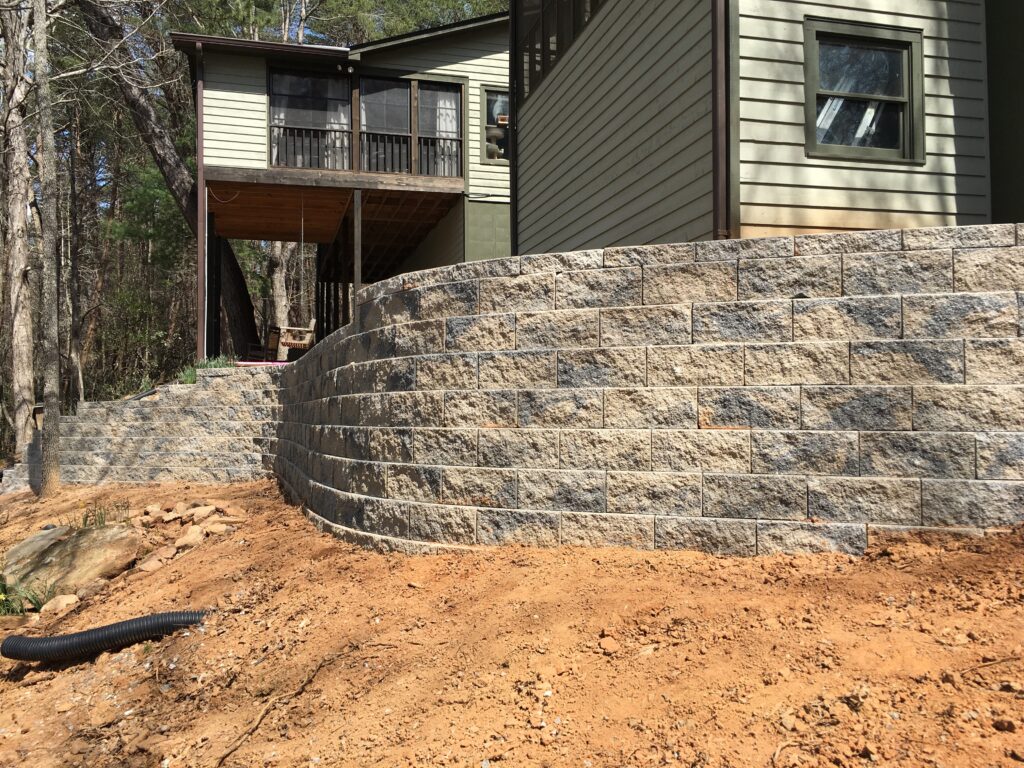
Retaining walls are architectural marvels that serve a crucial role in landscaping and construction, holding back soil and preventing erosion. When well-designed and properly constructed, they can stand the test of time, but like all structures, retaining walls can encounter issues leading to failure. If you’re looking to install a retaining wall on your property, then you may wonder”why do retaining walls fail?” Understanding the causes behind retaining wall failures is the first step in preventing them and ensuring the longevity of your construction. In this article, we’ll explore the common reasons behind retaining wall failures and the solutions to these issues. 1. Poor Drainage In the realm of retaining wall construction, inadequate drainage emerges as a formidable adversary, often lurking in the shadows, ready to strike when least expected. Understanding why poor drainage is a leading cause of retaining wall failure and implementing effective solutions is paramount to securing the structural integrity of these crucial landscape features. The Culprit: Imagine your retaining wall as a fortress, bravely standing guard against the relentless forces of soil and gravity. However, when rainwater or groundwater accumulates behind the wall due to subpar drainage, it unwittingly becomes a foe from within. Here’s how it wreaks havoc: The Solution: The battle against inadequate drainage begins with a well-thought-out strategy. Here are the key tactics for victory: By implementing drainage gravel, perforated pipes, and weep holes, you create a formidable defense against hydrostatic pressure and water-related threats. With these strategies in place, your retaining wall can stand strong, fulfilling its intended purpose for years to come 2. Insufficient Reinforcement Without adequate reinforcement, retaining walls, especially those of considerable height or bearing substantial loads, become vulnerable to a range of issues, from unsightly bulging to catastrophic failure. The Culprit: Your retaining wall is tasked with holding back tons of soil and defying the relentless pull of gravity. Yet, without proper reinforcement, this guardian may falter under the immense pressure it faces. Here’s how insufficient reinforcement undermines the wall’s resilience: The Solution: The path to reinforcing retaining walls involves a meticulous selection of strategies tailored to the wall’s specific needs. Here’s a strategic overview: Consultation with an Engineer The fortification journey of your retaining wall should begin with a consultation with a qualified engineer. These experts possess the knowledge and expertise to assess the wall’s specific requirements, including factors like height, soil type, and load-bearing capacity. They will determine the most suitable reinforcement strategy to safeguard the wall’s structural integrity. Additional Considerations: Proper reinforcement, whether through geogrids or geotextiles, empowers retaining walls to stand strong against the forces of gravity and soil movement. Consulting with an engineer ensures that your wall receives the tailored reinforcement it requires, delivering not only longevity but also peace of mind, knowing your landscape’s guardians are fortified for the task at hand. 3. Poor Retaining Wall Construction Materials The choice of materials and adherence to manufacturer recommendations can spell the difference between a resilient and long-lasting wall or one plagued by structural issues and a shortened lifespan. The Culprit: Imagine a retaining wall as a complex jigsaw puzzle, each piece carefully selected to fit together seamlessly. When subpar materials enter the equation or manufacturer recommendations are ignored, this intricate puzzle becomes riddled with weak links, jeopardizing the wall’s structural integrity. Here’s how inadequate materials or disregard for guidelines pose a threat: The Solution: The path to retaining wall success begins with a commitment to quality materials and strict adherence to manufacturer guidelines. Here’s a roadmap to fortify wall integrity: Additional Considerations: By making informed material choices and respecting manufacturer recommendations, you not only enhance the wall’s structural integrity but also ensure that it fulfills its purpose for years to come, weathering the challenges of time and nature with resilience and grace. 4. Improper Installation While the finest materials can form the foundation, it’s the skilled hands of experienced professionals who bring these materials to life in the form of a resilient and enduring wall. Understanding the critical role of proper installation, we delve into why even the best materials may falter without it and how to ensure the wall stands as a testament to structural integrity. The Culprit: Improper installation disrupts this harmony, introducing discordant notes that can undermine the wall’s stability. Here’s how incorrect installation practices can lead to issues: The Solution: Proper installation is the most important factor in retaining wall longevity. Here’s a comprehensive guide to ensuring that your wall is constructed to withstand the tests of time: Additional Considerations: Through alignment, base preparation, drainage considerations, and backfilling techniques, professionals ensure that the wall stands as a testament to structural integrity. When you embark on the journey of retaining wall construction, entrust it to the professionals who understand that proper installation is the cornerstone of a strong and durable wall. 5. Environmental Factors Environmental elements, such as freeze-thaw cycles, seismic activity, and flooding, can emerge as unexpected adversaries, inflicting stress that may lead to retaining wall failure. Understanding how these environmental factors pose challenges and how to fortify walls against them is essential for ensuring their resilience and longevity. The Culprit: The environment, in its unpredictable ways, can put your retaining wall to the test. Here’s how environmental elements can take a toll: The Solution to Environmental Factors Causing Retaining Wall Failure: The battle against environmental stress begins with a proactive approach that considers local conditions and implements appropriate reinforcements. Here’s how to fortify retaining walls against these challenges: Additional Considerations: Conclusion The integrity of retaining walls hinges on a delicate balance of multiple factors, from drainage and reinforcement to materials, installation, and environmental resilience. To safeguard the durability and stability of your retaining wall, it’s paramount to engage with seasoned professionals who possess the expertise to design and construct it in strict accordance with industry best practices and the unique requirements of your project. A retaining wall, when masterfully built and diligently maintained, serves not only as a functional guardian but also as an enduring testament to
How to Choose Artificial Grass for Your Home: 6 Important Choices
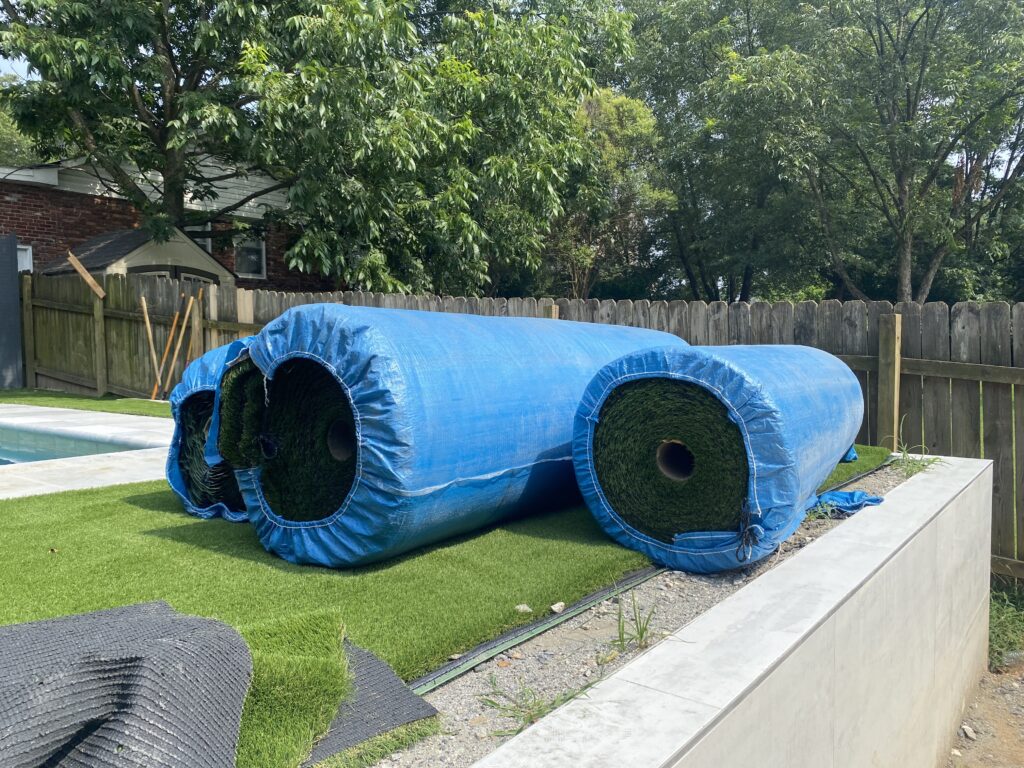
Artificial grass, also known as synthetic turf or fake grass, has come a long way in recent years. Its realistic appearance, low maintenance requirements, and eco-friendly benefits have made it a popular choice for lawns, sports fields, and landscaping projects. I’m sure that as a homeowner, you want to know how to choose artificial grass for your home. However, choosing the right artificial grass can be a bit overwhelming due to the variety of options available. In this comprehensive guide, we’ll walk you through the essential factors to consider when selecting artificial grass for your specific needs. Determine Your Purpose and Usage Selecting the right artificial grass for your project begins with a clear understanding of why you need it and how you plan to use it. This initial step is fundamental as it influences every aspect of your decision-making process. Let’s delve into why comprehending your purpose and usage is crucial: Aesthetic Appeal vs. Durability: Intended Use: Project Scope and Budget: By clearly defining your purpose and usage for artificial grass, you create a roadmap for your decision-making process. This understanding helps you prioritize specific characteristics and features that are most important for your project, ensuring that the artificial grass you select aligns with your goals and delivers the desired results. Whether you’re aiming for a beautiful backyard oasis or a robust sports field, this initial clarity sets the stage for a successful artificial grass installation. What Is the Best Pile Height for Artificial Grass? Pile height is a critical factor in choosing the right artificial grass for your specific application. It refers to the length of the artificial grass blades and has a profound impact on how the grass looks, feels, and performs. Here’s a deeper exploration of the importance of pile height and how it varies for different applications: Why Should I Choose Short Pile Artificial Grass? (Around 1/2 inch) Why Should I Choose Medium Pile Artificial Grass? (Around 1.5 inches) Why Should I Choose Long Pile Artificial Grass? (Over 2 inches) In summary, understanding pile height is crucial in tailoring your artificial grass selection to your specific needs. Short pile is durable and ideal for high-traffic areas, medium pile balances durability and comfort for general landscaping, while long pile provides a luxurious appearance and comfort but is best suited for low-traffic areas. By considering your intended use and aesthetic preferences, you can choose the pile height that best fits your project’s requirements and delivers the desired look and performance. What Material Should You Choose for Your Artificial Grass? Artificial grass, also known as synthetic turf or fake grass, comes in various materials, each with its unique characteristics and suitability for different applications. Here’s a detailed look at the primary materials used in artificial grass and how they impact its texture, appearance, durability, and cost: Polyethylene Polypropylene Nylon What’s the Best Artificial Grass Backing Material? The backing material of artificial grass plays a significant role in its overall durability, stability, and suitability for different applications. Two common backing materials are polyurethane (PU) and latex. Let’s delve deeper into the characteristics of each and how they affect the performance of artificial grass: Polyurethane (PU) Backing Latex Backing If your artificial grass will be installed outdoors, particularly in areas with extreme weather conditions, PU backing is the preferred choice due to its durability and resistance to temperature fluctuations. Latex-backed artificial grass is a cost-effective option, making it suitable for projects with tight budgets. However, it may be more suitable for indoor or mild climate applications. If you’re looking for long-term performance and minimal maintenance, PU-backed artificial grass is the better choice. It is less likely to deteriorate over time. Maintenance Requirements If you prefer minimal maintenance, consider selecting artificial grass varieties designed for low maintenance. These varieties are often engineered to resist matting, minimize static electricity buildup, and have excellent drainage systems to prevent water buildup. Additionally, some products are treated to resist staining and odors, reducing the need for frequent cleaning. While artificial grass is indeed low maintenance compared to natural grass, it’s essential to consider your willingness and ability to perform routine maintenance tasks. Occasional brushing, debris removal, cleaning, weed control, and inspections are part of the care required to keep your artificial grass looking its best. By choosing the right variety and understanding the maintenance involved, you can enjoy the benefits of artificial grass while keeping upkeep to a minimum. Warranty and Reputation Choosing a reputable manufacturer when purchasing artificial grass is a crucial step in ensuring that you receive a high-quality product that meets your expectations. Additionally, examining the warranty provided by the manufacturer is equally important, as it serves as a guarantee of the product’s quality and durability. Here’s a detailed explanation of why these considerations matter: Reputable Manufacturer Knowing that your artificial grass is backed by a warranty provides peace of mind. In the unlikely event of product defects or issues covered by the warranty, you have recourse for repairs or replacements. Artificial grass is an investment in your property. A good warranty safeguards that investment by ensuring that you receive a product that meets your expectations and performs as advertised. Conclusion In the pursuit of the perfect artificial grass for your project, several factors deserve meticulous consideration. Purpose, pile height, materials, blade shape, backing, drainage, infill, UV resistance, maintenance, warranty, and installation all play vital roles in shaping your decision. The careful evaluation of these elements not only defines the suitability of your artificial grass but also lays the foundation for years of enjoyment and performance. With each decision aligned with your specific goals and preferences, whether it’s to grace your backyard with a pristine lawn or to fortify a resilient sports field, you pave the way for a project that not only meets but surpasses your expectations. The benefits of artificial grass, from its aesthetic allure to its durability and ease of care, become yours to savor for years to come.
